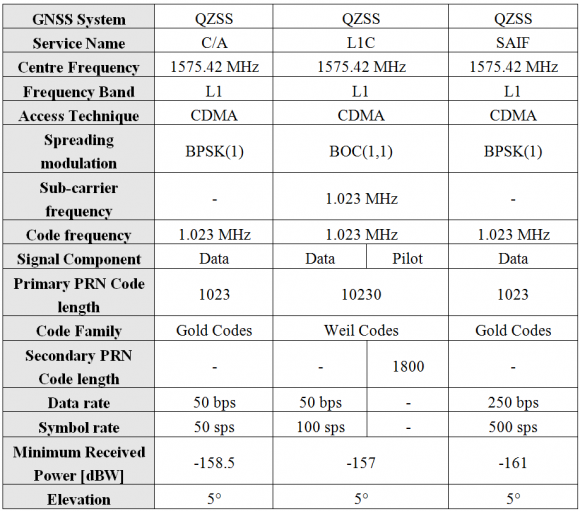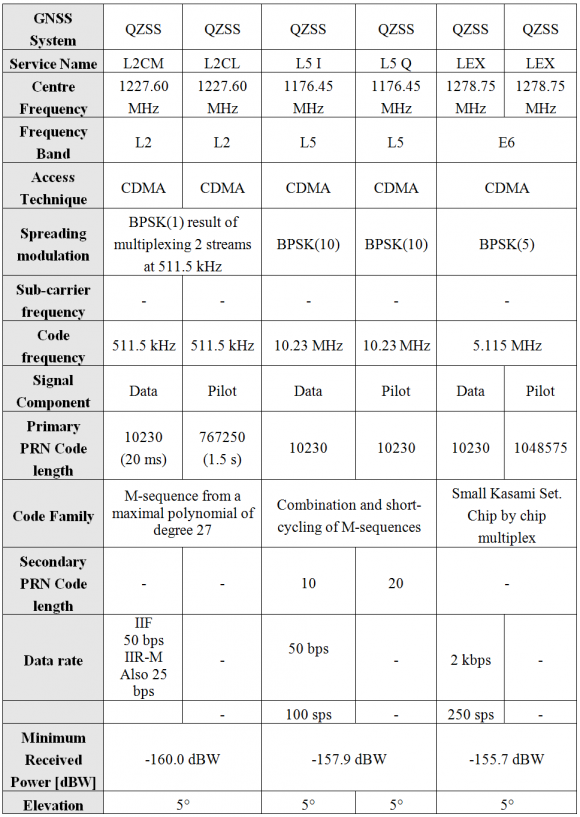If you wish to contribute or participate in the discussions about articles you are invited to contact the Editor
QZSS Signal Plan
| Fundamentals | |
|---|---|
| Title | QZSS Signal Plan |
| Author(s) | J.A Ávila Rodríguez, University FAF Munich, Germany. |
| Level | Advanced |
| Year of Publication | 2011 |
QZSS and GPS have the highest level of interoperability among all the Satellite Navigation Systems as we will see in the following tables. In fact, the spectral properties are equivalent to those of GPS. The characteristics of the different signals in particular are summarized in detail in the following tables. For the case of the L1 band the technical characteristics of the QZSS signals are presented next:
Equally, for L2, L5 and E6, the technical characteristics of the QZSS signals are summarized in the following table. As we can clearly recognize, except for the LEX(L6) signal in E6, QZSS and GPS are practically identical. It is interesting to note that this signal makes use of a very interesting multiplexing scheme for its experimental LEX(L6) signal, based on Code Shift Keying (CSK) [QZSS SIS ICD][1].
As a summary, the signal plan of QZSS is shown in the next figure and table [2][3][4]
| Frequency Band | L1 | L2 | L5 | L6 | ||||||||||
|---|---|---|---|---|---|---|---|---|---|---|---|---|---|---|
| Signal name | L1C/A | L1C/B | L1C | L1S | L2C | L5 | L61 (Block I) | L62 (Block II) | ||||||
| Modulation method | BPSK | BOC (Block IIA) | BOC (Block I) TMBOC (Block II) |
BOC | BPSK | BPSK | QPSK | BPSK | BPSK | |||||
| PRN code name | C/A | L1CP | L1CD | L1S | L2CL | L2CM | I5 | Q5 | L6 (code 1) | L6 (code 2) | L6 (code 1) | L6 (code 2) | ||
| Overlay code name | - | L1CO | - | - | - | - | Neuman-Hoffman | Neuman-Hoffman | - | - | - | - | ||
| Message name | LNAV(L1C/A, L1C/B) | - | CNAV2(L1C) | L1S | - | CNAV(L2C) | CNAV(L5) | L6D | - | L6D | L6E | |||
| Chip rate | 1023 Mcps | 1023 Mcps | 1023 Mcps | 1023 Mcps | 0.5115 | 0.5115 | 10.23 | 10.23 | 2.5575 Mcps | 2.5575 Mcps | 2.5575 Mcps | 2.5575 Mcps | ||
| Length | 1023 chips | 10230 chips | 10230 chips | 1023 chips | 767250 | 10230 | 10230 | 10230 | 10230 chip | 1048575 chip | 10230 chip | 10230 chip | ||
| Period | 1 ms | 10 ms | 10 ms | 1 ms | 1.5 s | 20 ms | 1 ms | 1 ms | 4 ms | 410 ms | 4 ms | 4 ms | ||
| Overlay Code | - | L1CO Length: 1800 bits Period: 18 s |
- | - | - | - | Neuman-Hoffman Length: 10 bits Period: 10 ms |
Neuman-Hoffman Length: 20 bits Period: 20 ms |
- | - | - | - | ||
| Bit rate | 50 bps | Approx. 50 bps | 250 bps | 25 bps | 50 bps | 2000 bps | 2000 bps | 2000 bps | ||||||
| Symbol Rate | - | 100 sps | 600 sps | 25 sps | 100 sps | 250 sps | 250 sps | 250 sps | ||||||
| Period (min. Frame) | 6 s | 18 s | 1 s | 12 s | 6 s | 1 s | 1 s | 1 s | ||||||
| Encoding method | Hamming Code | CRC, BCH, LDPC Interleave |
CRC Convolutional code |
CRC Convolutional code |
CRC Convolutional code |
RS (255, 223) | RS (255, 223) | RS (255, 223) | ||||||
| Nominal carrier frequency | 1575.42 MHz (=154 x f0) | 1227.60 MHz (=120 x f0) | 1176.45 MHz (=115xf0) | 1278.75 MHz (=125xf0) | ||||||||||
| Block I | 24.0 MHz (+- 12.0 MHz) | 24.0 MHz (+- 12.0 MHz) | 24.9 MHz (+- 12.45 MHz) | 39.0 MHz (+- 19.5 MHz) | ||||||||||
| Block II | 30.69 MHz (+- 15.345 MHz) | 30.69 MHz (+- 15.345 MHz) | 24.9 MHz (+- 12.45 MHz) | 42.0 MHz (+- 21.0 MHz) | ||||||||||
| Minimum received power | Block I | -158.5 dBW | - | -158.5 dBW | -163.0 dBW | -161.0 dBW | -160.0 dBW (Sum of L2CL and L2CM) | -157.9 dBW | -157.9 dBW | -155.7 dBW (Total power of Code 1 and Code 2) |
||||
| Block II | -158.5 dBW (-164.0 dBW for SV ID=7) |
-158.5 dBW (for Block IIA-Q) | -158.25 dBW (-162.4 dBW for SV ID=7) |
-163.0 dBW (-167.2 dBW for SV ID=7) |
-158.5 dBW | -158.5 dBW (Sum of L2CL and L2CM) | -157.9 dBW | -157.9 dBW | -156.82 dBW (Total power of Code 1 and Code 2) | |||||
References
- ^ [QZSS SIS ICD, 2007] Quasi Zenith Satellite System Navigation Service, Interface Specification for QZSS (IS-QZSS), Japan Aerospace Exploration Agency, January 22, 2007.
- ^ Quasi-Zenith Satellite System Interface Specification: Satellite Positioning, Navigation and Timing Service (IS-QZSS-PNT-004), Cabinet Office, January 25, 2021.
- ^ Quasi-Zenith Satellite System Interface Specification: Sub-meter Level Augmentation Service (IS-QZSS-L1S-004), Cabinet Office, December 27, 2019.
- ^ Quasi-Zenith Satellite System Interface Specification: Centimeter Level Augmentation Service (IS-QZSS-L6-004), Cabinet Office, July 14, 2021.
Credits
The information presented in this NAVIPEDIA’s article is an extract of the PhD work performed by Dr. Jose Ángel Ávila Rodríguez in the FAF University of Munich as part of his Doctoral Thesis “On Generalized Signal Waveforms for Satellite Navigation” presented in June 2008, Munich (Germany) and has evolved to reflect the system’s development, being updated by GMV.



